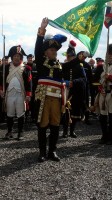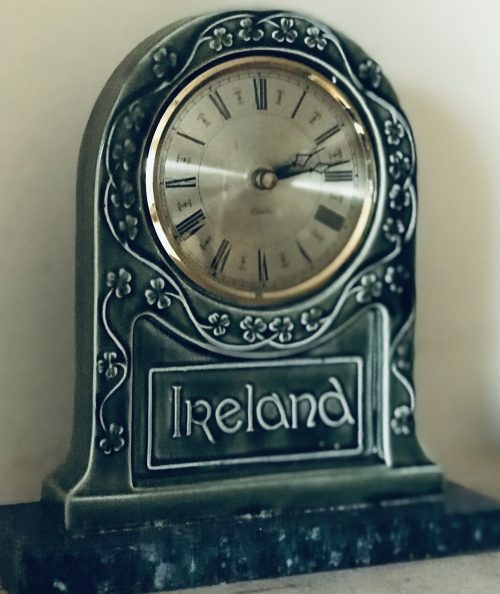-

 Real retro GAA hurling photo here of Kevin Hennessy of Cork & Conor Hayes of Galway marking each other in an All Ireland Final.Conor is wearing what appears to be a very old Cooper Ice hockey Head guard and it became his signature piece during his career as Galway Captain and Full Back. Kiltormer Co Galway 29cm x 23cm Conor Hayes was a three-time All-Star. He made his debut for the Galway senior hurlers during the 1979 championship and went on to play a key role for the Tribesmen for over a decade, winning three All-Irelands and two National Leagues. He was captain when Galway won back-to-back All-Ireland titles in 1987 and 1988. Conor is also an All-Ireland winner at club level, having achieved the highest honour in club hurling with Kiltormer in 1992. He is the holder of two Connacht club championships and three Galway hurling championships with Kiltormer and was named on the Galway Hurling Team of the Millennium. Kevin Hennessy (born 8 March 1961) is an Irish retired hurler who played as a left-corner forward for the Cork senior team. Born in Midleton, County Cork, Hennessy first arrived on the inter-county scene at the age of 18 when he first linked up with the Cork minor team, before later lining out with the under-21 side. He made his senior debut in the 1982 championship. Hennessy went on to play a key part for over a decade, and won three All-Ireland medals and seven Munster medals. He was an All-Ireland runner-up on three occasions. Hennessy represented the Munster inter-provincial team in the early stages of his career, winning two Railway Cup medals. At club level he won one All-Ireland medal, two Munster medals and four championship medals with Midleton. Throughout his career Hennessy made 22 championship appearances for Cork. He retired from inter-county hurling following the conclusion of the 1993 championship.
Real retro GAA hurling photo here of Kevin Hennessy of Cork & Conor Hayes of Galway marking each other in an All Ireland Final.Conor is wearing what appears to be a very old Cooper Ice hockey Head guard and it became his signature piece during his career as Galway Captain and Full Back. Kiltormer Co Galway 29cm x 23cm Conor Hayes was a three-time All-Star. He made his debut for the Galway senior hurlers during the 1979 championship and went on to play a key role for the Tribesmen for over a decade, winning three All-Irelands and two National Leagues. He was captain when Galway won back-to-back All-Ireland titles in 1987 and 1988. Conor is also an All-Ireland winner at club level, having achieved the highest honour in club hurling with Kiltormer in 1992. He is the holder of two Connacht club championships and three Galway hurling championships with Kiltormer and was named on the Galway Hurling Team of the Millennium. Kevin Hennessy (born 8 March 1961) is an Irish retired hurler who played as a left-corner forward for the Cork senior team. Born in Midleton, County Cork, Hennessy first arrived on the inter-county scene at the age of 18 when he first linked up with the Cork minor team, before later lining out with the under-21 side. He made his senior debut in the 1982 championship. Hennessy went on to play a key part for over a decade, and won three All-Ireland medals and seven Munster medals. He was an All-Ireland runner-up on three occasions. Hennessy represented the Munster inter-provincial team in the early stages of his career, winning two Railway Cup medals. At club level he won one All-Ireland medal, two Munster medals and four championship medals with Midleton. Throughout his career Hennessy made 22 championship appearances for Cork. He retired from inter-county hurling following the conclusion of the 1993 championship. -
Out of stock

 62cm x 72cm Scarriff Co Clare This extremely rare print commemorates three Catholic priests killed during the bloody War of Independence between the IRA and British Crown Forces : Fr James O’Callaghan Clogheen,Canon Magnier Dunmanway and Fr Michael Griffin Galway .Indeed the 100 year anniversaries of three callous murders are all due in the next few months. Fr O Callaghan was shot in cold blood in Cork city by a group of drunken Black and Tans.Canon Magnier,an elderly priest in poor health, was shot along with a young parishioner outside the village of Dunmanway in Co Cork and Fr Griffin was taken from his home and assassinated in Galway .An estimated 20,000 people attended his funeral. This poignant and extremely rare print,dating from that period pays homage to these holy men who were all cruelly murdered in cold blood whilst unarmed by tyrannical British Military forces.The notorious murder of a young West of Ireland priest who was lured from his home before being shot in the head and buried in a bog by British forces is to be commemorated with a series of events in Galway City next year. The disappearance and murder of Fr Michael Griffin (28) sent shock waves across Ireland in November 1920, prompting a front-page news story in the New York Times, a cable expressing outrage from the Bishop of Chicago, and tough questions about British atrocities in Ireland in the British Parliament. It was one of the most notorious killings of the War of Independence when reprisals were commonplace, and the hated Black and Tans – recruited from Britain to put the rebellious Irish in their place – roamed the land. The body of the popular young curate was discovered in an unmarked grave in bogland a few miles west of Galway City six days after his disappearance and, from the outset, locals in Galway blamed the Black and Tans for the shocking crime. An estimated crowd of 12,000 people gathered outside St Joseph’s Church in Galway City for his Requiem Mass, which was concelebrated by the Archbishop of Tuam, the bishops of Galway and Clonfert, and almost 150 priests from across the West of Ireland. A native of East Galway, Fr Griffin was suspected of having republican sympathies by British forces at the time, who were angered by the disappearance of a local primary school principal, Patrick Joyce, a week before the young priest went missing. Joyce was accused of feeding information to the crown forces by members of the Irish Republican Brotherhood (IRB), who had intercepted five of his letters at the mail sorting office in Galway. Collusion with the despised British crown forces was seen as treason at the time and Joyce was shot in the head by republicans after they presented him with evidence at a secret trial in an isolated house outside the city. November 1920 was a particularly violent time in Galway. A pregnant young woman had been shot by the Black and Tans outside her family home in rural Ardrahan, two Galway city men had been shot dead, and republican prisoners were on hunger strike in Galway gaol. Men from the area had been interned without trial, there was a curfew across the city, and British forces were highly suspicious of young priests like Fr Griffin, who were believed to have republican sympathies. Members of the St Joseph’s Parish Council formed a new committee this week to organize a series of events in Fr Griffin’s memory in Galway in November of next year. Although the city will be in “party mode” when Galway becomes the European Capital of Culture in 2020, committee chairman Cllr John Connolly believes people need to remember their history and the sacrifices made in Galway to secure Irish freedom.“A lot of people don’t realise how tough life was in Galway during the War of Independence. Between the beginning of September and the end of November 1920, you had the death of Seamus Quirke, Sean Mulvoy, and Michael Walsh, who was a member of the Urban District Council,” Connolly told IrishCentral this week. “They were all known republicans and republican sympathisers. You also had the death of Patrick Joyce, who was the principal of Bearna National School, who was of a different political persuasion. He was considered an informer, who was informing the British forces in Galway of the activities of the Irish Republican Brotherhood (IRB).” The British believed Fr Griffin had given the last rites to Walsh and Quirke, two well-known republicans in Galway. They also believed he may have heard the last confession of Patrick Joyce and that he knew who had abducted him. Controversy surrounded Joyce’s case for decades, as his body was only found in a field to the west of Galway in the 1990s. His direct family – who emigrated to Australia – always maintained his innocence of collusion allegations. “The Black and Tans really went on the rampage in Galway when Joyce disappeared, throwing grenades into houses, killing livestock belonging to people, and burning the premises of the Galway Express newspaper,” recalled Connolly this week. “Fr Griffin went missing on November 14 and his body was found on the 20th. Locals believed that people in the area knew where the body was, but they were afraid of uncovering it in case of reprisals from British forces, who were searching for Patrick Joyce at that stage,” said Cllr Connolly. It is known that three men called to Fr Griffin’s house at Montpellier Terrace late on a Sunday night and that he agreed to accompany them. A neighbor heard him speak to the men, who were Irish, at the front door and he was never seen again. Historians believe the British shot him at their nearby base at Lenaboy Castle, Taylor’s Hill, that same night and then dumped him in an unmarked grave. Locals found the body on the following Saturday evening but were so afraid of the British that they waited until 7 am on Sunday morning before bringing his body to St Joseph’s Church in the city. Fr Griffin was found with a bullet in his head, indicating he had been shot at close range. “He was brought in on a horse and cart. They had to disguise the cart with large milk churns, in case the British forces stopped them. The British were still looking for Patrick Joyce and they were upset that he had been kidnapped. They saw his disappearance as a direct threat to their own intelligence operation,” explained Connolly. “The idea that a clergyman would be treated like this was a new low I think for the British forces in the city and, indeed in the country, that they had taken this action against a priest.” Fr Griffin from Gurteen, Co Galway, had a great love for the Irish language and was popular for his dealings with the old, the young, and the poor. He was moved by the injustice he witnessed around him every day due to the British occupation. As soon as he was reported missing, locals in Galway blamed the British crown forces. After his disappearance, Bishop O’Dea and the priests of Galway issued a statement to condemn his abduction from his home. “We cannot but hold the British Government responsible for this outrage upon the Catholic priesthood of Ireland,” they said. “He has been secretly forced from his house in the dead of night by undisciplined men. Without warrant, or charge, or proof of wrongdoing he has been deprived of his liberty and, for all we know, his life. Unhappily, the only uncommon feature in this case is that he is a priest; the crime in this respect being almost unique; in as much as every civilised country in the world recognises priests as men of peace, and treats them as such.” Connolly and Fr Martin Downey, Parish Priest of St Joseph’s, have formed a new committee to organize a series of events to remember the popular young priest next November. “Really and truly, Fr Griffin got no trial. It’s fitting that his centenary should be commemorated because it was a bleak time in Galway. That a highly respected member of the community was taken out and killed like this, we do need to remind ourselves that Galway was a dark place at the time and the sacrifice of those who lost their lives should not be forgotten,” said Connolly.
62cm x 72cm Scarriff Co Clare This extremely rare print commemorates three Catholic priests killed during the bloody War of Independence between the IRA and British Crown Forces : Fr James O’Callaghan Clogheen,Canon Magnier Dunmanway and Fr Michael Griffin Galway .Indeed the 100 year anniversaries of three callous murders are all due in the next few months. Fr O Callaghan was shot in cold blood in Cork city by a group of drunken Black and Tans.Canon Magnier,an elderly priest in poor health, was shot along with a young parishioner outside the village of Dunmanway in Co Cork and Fr Griffin was taken from his home and assassinated in Galway .An estimated 20,000 people attended his funeral. This poignant and extremely rare print,dating from that period pays homage to these holy men who were all cruelly murdered in cold blood whilst unarmed by tyrannical British Military forces.The notorious murder of a young West of Ireland priest who was lured from his home before being shot in the head and buried in a bog by British forces is to be commemorated with a series of events in Galway City next year. The disappearance and murder of Fr Michael Griffin (28) sent shock waves across Ireland in November 1920, prompting a front-page news story in the New York Times, a cable expressing outrage from the Bishop of Chicago, and tough questions about British atrocities in Ireland in the British Parliament. It was one of the most notorious killings of the War of Independence when reprisals were commonplace, and the hated Black and Tans – recruited from Britain to put the rebellious Irish in their place – roamed the land. The body of the popular young curate was discovered in an unmarked grave in bogland a few miles west of Galway City six days after his disappearance and, from the outset, locals in Galway blamed the Black and Tans for the shocking crime. An estimated crowd of 12,000 people gathered outside St Joseph’s Church in Galway City for his Requiem Mass, which was concelebrated by the Archbishop of Tuam, the bishops of Galway and Clonfert, and almost 150 priests from across the West of Ireland. A native of East Galway, Fr Griffin was suspected of having republican sympathies by British forces at the time, who were angered by the disappearance of a local primary school principal, Patrick Joyce, a week before the young priest went missing. Joyce was accused of feeding information to the crown forces by members of the Irish Republican Brotherhood (IRB), who had intercepted five of his letters at the mail sorting office in Galway. Collusion with the despised British crown forces was seen as treason at the time and Joyce was shot in the head by republicans after they presented him with evidence at a secret trial in an isolated house outside the city. November 1920 was a particularly violent time in Galway. A pregnant young woman had been shot by the Black and Tans outside her family home in rural Ardrahan, two Galway city men had been shot dead, and republican prisoners were on hunger strike in Galway gaol. Men from the area had been interned without trial, there was a curfew across the city, and British forces were highly suspicious of young priests like Fr Griffin, who were believed to have republican sympathies. Members of the St Joseph’s Parish Council formed a new committee this week to organize a series of events in Fr Griffin’s memory in Galway in November of next year. Although the city will be in “party mode” when Galway becomes the European Capital of Culture in 2020, committee chairman Cllr John Connolly believes people need to remember their history and the sacrifices made in Galway to secure Irish freedom.“A lot of people don’t realise how tough life was in Galway during the War of Independence. Between the beginning of September and the end of November 1920, you had the death of Seamus Quirke, Sean Mulvoy, and Michael Walsh, who was a member of the Urban District Council,” Connolly told IrishCentral this week. “They were all known republicans and republican sympathisers. You also had the death of Patrick Joyce, who was the principal of Bearna National School, who was of a different political persuasion. He was considered an informer, who was informing the British forces in Galway of the activities of the Irish Republican Brotherhood (IRB).” The British believed Fr Griffin had given the last rites to Walsh and Quirke, two well-known republicans in Galway. They also believed he may have heard the last confession of Patrick Joyce and that he knew who had abducted him. Controversy surrounded Joyce’s case for decades, as his body was only found in a field to the west of Galway in the 1990s. His direct family – who emigrated to Australia – always maintained his innocence of collusion allegations. “The Black and Tans really went on the rampage in Galway when Joyce disappeared, throwing grenades into houses, killing livestock belonging to people, and burning the premises of the Galway Express newspaper,” recalled Connolly this week. “Fr Griffin went missing on November 14 and his body was found on the 20th. Locals believed that people in the area knew where the body was, but they were afraid of uncovering it in case of reprisals from British forces, who were searching for Patrick Joyce at that stage,” said Cllr Connolly. It is known that three men called to Fr Griffin’s house at Montpellier Terrace late on a Sunday night and that he agreed to accompany them. A neighbor heard him speak to the men, who were Irish, at the front door and he was never seen again. Historians believe the British shot him at their nearby base at Lenaboy Castle, Taylor’s Hill, that same night and then dumped him in an unmarked grave. Locals found the body on the following Saturday evening but were so afraid of the British that they waited until 7 am on Sunday morning before bringing his body to St Joseph’s Church in the city. Fr Griffin was found with a bullet in his head, indicating he had been shot at close range. “He was brought in on a horse and cart. They had to disguise the cart with large milk churns, in case the British forces stopped them. The British were still looking for Patrick Joyce and they were upset that he had been kidnapped. They saw his disappearance as a direct threat to their own intelligence operation,” explained Connolly. “The idea that a clergyman would be treated like this was a new low I think for the British forces in the city and, indeed in the country, that they had taken this action against a priest.” Fr Griffin from Gurteen, Co Galway, had a great love for the Irish language and was popular for his dealings with the old, the young, and the poor. He was moved by the injustice he witnessed around him every day due to the British occupation. As soon as he was reported missing, locals in Galway blamed the British crown forces. After his disappearance, Bishop O’Dea and the priests of Galway issued a statement to condemn his abduction from his home. “We cannot but hold the British Government responsible for this outrage upon the Catholic priesthood of Ireland,” they said. “He has been secretly forced from his house in the dead of night by undisciplined men. Without warrant, or charge, or proof of wrongdoing he has been deprived of his liberty and, for all we know, his life. Unhappily, the only uncommon feature in this case is that he is a priest; the crime in this respect being almost unique; in as much as every civilised country in the world recognises priests as men of peace, and treats them as such.” Connolly and Fr Martin Downey, Parish Priest of St Joseph’s, have formed a new committee to organize a series of events to remember the popular young priest next November. “Really and truly, Fr Griffin got no trial. It’s fitting that his centenary should be commemorated because it was a bleak time in Galway. That a highly respected member of the community was taken out and killed like this, we do need to remind ourselves that Galway was a dark place at the time and the sacrifice of those who lost their lives should not be forgotten,” said Connolly. 2
2John Connolly and Fr Martin Downey, with a photo of Fr Griffin, courtesy of Ciaran Tierney Digital Storyteller.
Reprisal Killing of Cork PriestIn the aftermath of the devestating attack on a police patrol at Blackpool in Cork City on May 14, 1921, in which three RIC members lost their life, large forces of military and police flooded the area and much of the Blackpool area was ransacked. Several arrests were made and throughout the city, rumours circulated of major military operations involving widespread savage reprisals. Just before 4am, on the following morning, the Sundays Well home of Alderman Liam De Roiste was raided by a group of masked men, all members of the Royal Irish Constabulary. He himself was not at home, but Father Seamus O'Callaghan, a curate based at Clogheen on the outskirts of the city, happened to be in the house at the time. Having been awakened by the hammering at the door, Fr O'Callaghan went to the window and informed the men outside that De Roiste was not at home. The front door was then broken in and at least one of the police ran up the stairs and fired a number of shots at the priest, who fell mortally wounded. The assailaints then made their escape. Fr O'Callaghan died a number of hours later. A native of Newcestown, West Cork, he was widely admired by the people of Cork having, as a young man, closely identified himself with the Nationalist cause. His funeral was attended by many thousands, despite widespread intimidation of the mourners by crown forces. He is buried in the grounds of the Church of the Most Precious Blood, Clogheen. -

 Fantastic panoramic photo of the modern Croke Park,one of the most iconic sporting venues in the World. Dimensions: 36cm x110cm Croke Park (Irish: Páirc an Chrócaigh) is a Gaelic games stadium located in Dublin, Ireland. Named after Archbishop Thomas Croke, it is sometimes called Croker by GAA fans and locals. It serves as both the principal stadium and headquarters of the Gaelic Athletic Association (GAA). Since 1891 the site has been used by the GAA to host Gaelic sports, including the annual All-Ireland in Gaelic football and hurling. A major expansion and redevelopment of the stadium ran from 1991–2005, raising capacity to its current 82,300 spectators. This makes Croke Park the third-largest stadium in Europe, and the largest not usually used for association football. Other events held at the stadium include the opening and closing ceremonies of the 2003 Special Olympics, and numerous musical concerts. In 2012, Irish pop group Westlife sold out the stadium in record-breaking time: less than 5 minutes. From 2007–10, Croke Park hosted home matches of the Ireland national rugby union team and the Republic of Ireland national football team, while their new Aviva Stadium was constructed. This use of Croke Park for non-Gaelic sports was controversial and required temporary changes to GAA rules. In June 2012, the stadium hosted the closing ceremony of the 50th International Eucharistic Congress during which Pope Benedict XVI gave an address over video link.
Fantastic panoramic photo of the modern Croke Park,one of the most iconic sporting venues in the World. Dimensions: 36cm x110cm Croke Park (Irish: Páirc an Chrócaigh) is a Gaelic games stadium located in Dublin, Ireland. Named after Archbishop Thomas Croke, it is sometimes called Croker by GAA fans and locals. It serves as both the principal stadium and headquarters of the Gaelic Athletic Association (GAA). Since 1891 the site has been used by the GAA to host Gaelic sports, including the annual All-Ireland in Gaelic football and hurling. A major expansion and redevelopment of the stadium ran from 1991–2005, raising capacity to its current 82,300 spectators. This makes Croke Park the third-largest stadium in Europe, and the largest not usually used for association football. Other events held at the stadium include the opening and closing ceremonies of the 2003 Special Olympics, and numerous musical concerts. In 2012, Irish pop group Westlife sold out the stadium in record-breaking time: less than 5 minutes. From 2007–10, Croke Park hosted home matches of the Ireland national rugby union team and the Republic of Ireland national football team, while their new Aviva Stadium was constructed. This use of Croke Park for non-Gaelic sports was controversial and required temporary changes to GAA rules. In June 2012, the stadium hosted the closing ceremony of the 50th International Eucharistic Congress during which Pope Benedict XVI gave an address over video link.City and Suburban Racecourse
The area now known as Croke Park was owned in the 1880s by Maurice Butterly and known as the City and Suburban Racecourse, or Jones' Road sports ground. From 1890 it was also used by the Bohemian Football Club. In 1901 Jones' Road hosted the IFA Cup football final when Cliftonville defeated Freebooters.History
Recognising the potential of the Jones' Road sports ground a journalist and GAA member, Frank Dineen, borrowed much of the £3,250 asking price and bought the ground in 1908. In 1913 the GAA came into exclusive ownership of the plot when they purchased it from Dineen for £3,500. The ground was then renamed Croke Park in honour of Archbishop Thomas Croke, one of the GAA's first patrons. In 1913, Croke Park had only two stands on what is now known as the Hogan stand side and grassy banks all round. In 1917, a grassy hill was constructed on the railway end of Croke Park to afford patrons a better view of the pitch. This terrace was known originally as Hill 60, later renamed Hill 16 in memory of the 1916 Easter Rising. It is erroneously believed to have been built from the ruins of the GPO, when it was constructed the previous year in 1915. In the 1920s, the GAA set out to create a high capacity stadium at Croke Park. Following the Hogan Stand, the Cusack Stand, named after Michael Cusack from Clare (who founded the GAA and served as its first secretary), was built in 1927. 1936 saw the first double-deck Cusack Stand open with 5,000 seats, and concrete terracing being constructed on Hill 16. In 1952 the Nally Stand was built in memorial of Pat Nally, another of the GAA founders. Seven years later, to celebrate the 75th anniversary of the GAA, the first cantilevered "New Hogan Stand" was opened. The highest attendance ever recorded at an All-Ireland Senior Football Championship Final was 90,556 for Offaly v Down in 1961. Since the introduction of seating to the Cusack stand in 1966, the largest crowd recorded has been 84,516.Bloody Sunday
During the Irish War of Independence on 21 November 1920 Croke Park was the scene of a massacre by the Royal Irish Constabulary (RIC). The Police, supported by the British Auxiliary Division, entered the ground and began shooting into the crowd, killing or fatally wounding 14 civilians during a Dublin-Tipperary Gaelic football match. The dead included 13 spectators and Tipperary player Michael Hogan. Posthumously, the Hogan stand built in 1924 was named in his honour. These shootings, on the day which became known as Bloody Sunday, were a reprisal for the killing of 15 people associated with the Cairo Gang, a group of British Intelligence officers, by Michael Collins' 'squad' earlier that day.Dublin Rodeo
In 1924, American rodeo promoter, Tex Austin, staged the Dublin Rodeo, Ireland's first professional rodeo at Croke Park Stadium. For seven days, with two shows each day from August 18 to August 24, sell out crowds saw cowboys and cowgirls from Canada, the United States, Mexico, Argentina and Australia compete for rodeo championship titles.Canadian bronc riders such as Andy Lund and his brother Art Lund, trick riders such as Ted Elder and Vera McGinnis were among the contestants. British Pathe filmed some of the rodeo events.Stadium design
In 1984 the organisation decided to investigate ways to increase the capacity of the old stadium. The design for an 80,000 capacity stadium was completed in 1991. Gaelic sports have special requirements as they take place on a large field. A specific requirement was to ensure the spectators were not too far from the field of play. This resulted in the three-tier design from which viewing games is possible: the main concourse, a premium level incorporating hospitality facilities and an upper concourse. The premium level contains restaurants, bars and conference areas. The project was split into four phases over a 14-year period. Such was the importance of Croke Park to the GAA for hosting big games, the stadium did not close during redevelopment. During each phase different parts of the ground were redeveloped, while leaving the rest of the stadium open. Big games, including the annual All-Ireland Hurling and Football finals, were played in the stadium throughout the development.Phase one – New Cusack Stand
The first phase of construction was to build a replacement for Croke Park's Cusack Stand. A lower deck opened for use in 1994. The upper deck opened in 1995. Completed at a cost of £35 million, the new stand is 180 metres long, 35 metres high, has a capacity for 27,000 people and contains 46 hospitality suites. The new Cusack Stand contains three tiers from which viewing games is possible: the main concourse, a premium level incorporating hospitality facilities and finally an upper concourse. One end of the pitch was closer to the stand after this phase, as the process of slightly re-aligning the pitch during the redevelopment of the stadium began. The works were carried out by Sisk Group.Phase two – Davin Stand
Phase Two of the development started in late 1998 and involved extending the new Cusack Stand to replace the existing Canal End terrace. It involved reacquiring a rugby pitch that had been sold to Belvedere College in 1910 by Frank Dineen. In payment and part exchange, the college was given the nearby Distillery Road sportsgrounds.[19] It is now known as The Davin Stand (Irish: Ardán Dáimhím), after Maurice Davin, the first president of the GAA. This phase also saw the creation of a tunnel which was later named the Ali tunnel in honour of Muhammad Ali and his fight against Al Lewis in July 1972 in Croke Park.Phase three – Hogan Stand
Phase Three saw the building of the new Hogan Stand. This required a greater variety of spectator categories to be accommodated including general spectators, corporate patrons, VIPs, broadcast and media services and operation staff. Extras included a fitted-out mezzanine level for VIP and Ard Comhairle (Where the dignitaries sit) along with a top-level press media facility. The end of Phase Three took the total spectator capacity of Croke Park to 82,000.Phase four – Nally Stand & Nally End/Dineen Hill 16 terrace
After the 2003 Special Olympics, construction began in September 2003 on the final phase, Phase Four. This involved the redevelopment of the Nally Stand, named after the athlete Pat Nally, and Hill 16 into a new Nally End/Dineen Hill 16 terrace. While the name Nally had been used for the stand it replaced, the use of the name Dineen was new, and was in honour of Frank Dineen, who bought the original stadium for the GAA in 1908, giving it to them in 1913. The old Nally Stand was taken away and reassembled in Pairc Colmcille, home of Carrickmore GAA in County Tyrone. The phase four development was officially opened by the then GAA President Seán Kelly on 14 March 2005. For logistical reasons (and, to a degree, historical reasons), and also to provide cheaper high-capacity space, the area is a terrace rather than a seated stand, the only remaining standing-room in Croke Park. Unlike the previous Hill, the new terrace was divided into separate sections – Hill A (Cusack stand side), Hill B (behind the goals) and the Nally terrace (on the site of the old Nally Stand). The fully redeveloped Hill has a capacity of around 13,200, bringing the overall capacity of the stadium to 82,300. This made the stadium the second biggest in the EU after the Camp Nou, Barcelona. However, London's new Wembley stadium has since overtaken Croke Park in second place. The presence of terracing meant that for the brief period when Croke Park hosted international association football during 2007–2009, the capacity was reduced to approximately 73,500, due to FIFA's statutes stating that competitive games must be played in all-seater stadiums.Pitch
The pitch in Croke Park is a soil pitch that replaced the Desso GrassMaster pitch laid in 2002. This replacement was made after several complaints by players and managers that the pitch was excessively hard and far too slippery. Since January 2006, a special growth and lighting system called the SGL Concept has been used to assist grass growing conditions, even in the winter months. The system, created by Dutch company SGL (Stadium Grow Lighting), helps in controlling and managing all pitch growth factors, such as light, temperature, CO2, water, air and nutrients.Floodlighting
With the 2007 Six Nations clash with France and possibly other matches in subsequent years requiring lighting the GAA installed floodlights in the stadium (after planning permission was granted). Indeed, many other GAA grounds around the country have started to erect floodlights as the organisation starts to hold games in the evenings, whereas traditionally major matches were played almost exclusively on Sunday afternoons. The first game to be played under these lights at Croke Park was a National Football League Division One match between Dublin and Tyrone on 3 February 2007 with Tyrone winning in front of a capacity crowd of over 81,000 – which remains a record attendance for a National League game, with Ireland's Six Nations match with France following on 11 February. Temporary floodlights were installed for the American Bowl game between Chicago Bears and Pittsburgh Steelers on the pitch in 1997, and again for the 2003 Special Olympics.Concert
Date Performer(s) Opening act(s) Tour/Event Attendance Notes 29 June 1985 U2 In Tua Nua, R.E.M., The Alarm, Squeeze The Unforgettable Fire Tour 57,000 First Irish act to have a headline concert. Part of the concert was filmed for the group's documentary Wide Awake in Dublin. 28 June 1986 Simple Minds Once Upon A Time Tour Guest appearance by Bono 27 June 1987 U2 Light A Big Fire, The Dubliners, The Pogues, Lou Reed The Joshua Tree Tour 114,000 28 June 1987 Christy Moore, The Pretenders, Lou Reed, Hothouse Flowers 28 June 1996 Tina Turner Brian Kennedy Wildest Dreams Tour 40,000/40,000 16 May 1997 Garth Brooks World Tour II 18 May 1997 29 May 1998 Elton John & Billy Joel Face to Face 1998 30 May 1998 24 June 2005 U2 The Radiators from Space, The Thrills, The Bravery, Snow Patrol, Paddy Casey, Ash Vertigo Tour 246,743 25 June 2005 27 June 2005 20 May 2006 Bon Jovi Nickelback Have a Nice Day Tour 81,327 9 June 2006 Robbie Williams Basement Jaxx Close Encounters Tour 6 October 2007 The Police Fiction Plane The Police Reunion Tour 81,640 Largest attendance of the tour. 31 May 2008 Celine Dion Il Divo Taking Chances World Tour 69,725 Largest attendance for a solo female act 1 June 2008 Westlife Shayne Ward Back Home Tour 85,000 Second Irish act to have a headline concert. Largest attendance of the tour. Part of the concert was filmed for the group's documentary and concert DVD 10 Years of Westlife - Live at Croke Park Stadium. 14 June 2008 Neil Diamond 13 June 2009 Take That The Script Take That Present: The Circus Live 24 July 2009 U2 Glasvegas, Damien Dempsey U2 360° Tour 243,198 25 July 2009 Kaiser Chiefs, Republic of Loose 27 July 2009 Bell X1, The Script The performances of "New Year's Day" and "I'll Go Crazy If I Don't Go Crazy Tonight" were recorded for the group's live album U22 and for the band's remix album Artificial Horizon and the live EP Wide Awake in Europe, respectively. 5 June 2010 Westlife Wonderland, WOW, JLS, Jedward Where We Are Tour 86,500 Largest attendance of the tour. 18 June 2011 Take That Pet Shop Boys Progress Live 154,828 19 June 2011 22 June 2012 Westlife Jedward, The Wanted, Lawson Greatest Hits Tour 187,808[24] The 23 June 2012 date broke the stadium record for selling out its tickets in four minutes. Eleventh largest attendance at an outdoor stadium worldwide. Largest attendance of the tour and the band's music career history. Part of the concert was filmed for the group's documentary and concert DVD The Farewell Tour - Live in Croke Park. 23 June 2012 26 June 2012 Red Hot Chili Peppers Noel Gallagher's High Flying Birds, The Vaccines I'm with You World Tour 23 May 2014 One Direction 5 Seconds of Summer Where We Are Tour 235,008 24 May 2014 25 May 2014 20 June 2015 The Script & Pharrell Williams No Sound Without Silence Tour 74,635 24 July 2015 Ed Sheeran x Tour 162,308 25 July 2015 27 May 2016 Bruce Springsteen The River Tour 2016 160,188 29 May 2016 9 July 2016 Beyoncé Chloe x Halle, Ingrid Burley The Formation World Tour 68,575 8 July 2017 Coldplay AlunaGeorge, Tove Lo A Head Full of Dreams Tour[25] 80,398 22 July 2017 U2 Noel Gallagher's High Flying Birds The Joshua Tree Tour 2017 80,901 17 May 2018 The Rolling Stones The Academic No Filter Tour 64,823 15 June 2018 Taylor Swift Camila Cabello, Charli XCX Taylor Swift's Reputation Stadium Tour 136.000 Swift became the first woman headline two concerts in a row there. 16 June 2018 7 July 2018 Michael Bublé Emeli Sandé 24 May 2019 Spice Girls Jess Glynne Spice World - 2019 UK Tour 5 July 2019 Westlife James Arthur Wild Youth The 20 Touror The Twenty Tour The 5 July 2019 date sold out its tickets in six minutes. Second date released were also sold out in under forty-eight hours. 6 July 2019 Non-Gaelic games
There was great debate in Ireland regarding the use of Croke Park for sports other than those of the GAA. As the GAA was founded as a nationalist organisation to maintain and promote indigenous Irish sport, it has felt honour-bound throughout its history to oppose other, foreign (in practice, British), sports. In turn, nationalist groups supported the GAA as the prime example of purely Irish sporting culture. Until its abolition in 1971, rule 27 of the GAA constitution stated that a member of the GAA could be banned from playing its games if found to be also playing association football, rugby or cricket. That rule was abolished but rule 42 still prohibited the use of GAA property for games with interests in conflict with the interests of the GAA. The belief was that rugby and association football were in competition with Gaelic football and hurling, and that if the GAA allowed these sports to use their ground it might be harmful to Gaelic games, while other sports, not seen as direct competitors with Gaelic football and hurling, were permitted, such as the two games of American football (Croke Park Classic college football game between The University of Central Florida and Penn State, and an American Bowl NFL preseason game between the Chicago Bears and the Pittsburgh Steelers) on the Croke Park pitch during the 1990s.[27] On 16 April 2005, a motion to temporarily relax rule No. 42 was passed at the GAA Annual Congress. The motion gives the GAA Central Council the power to authorise the renting or leasing of Croke Park for events other than those controlled by the Association, during a period when Lansdowne Road – the venue for international soccer and rugby matches – was closed for redevelopment. The final result was 227 in favour of the motion to 97 against, 11 votes more than the required two-thirds majority. In January 2006, it was announced that the GAA had reached agreement with the Football Association of Ireland (FAI) and Irish Rugby Football Union (IRFU) to stage two Six Nations games and four soccer internationals at Croke Park in 2007 and in February 2007, use of the pitch by the FAI and the IRFU in 2008 was also agreed.These agreements were within the temporary relaxation terms, as Lansdowne Road was still under redevelopment until 2010. Although the GAA had said that hosted use of Croke Park would not extend beyond 2008, irrespective of the redevelopment progress, fixtures for the 2009 Six Nations rugby tournament saw the Irish rugby team using Croke park for a third season. 11 February 2007 saw the first rugby union international to be played there. Ireland were leading France in a Six Nations clash, but lost 17–20 after conceding a last minute (converted) try. Raphael Ibanez scored the first try in that match; Ronan O'Gara scored Ireland's first ever try in Croke Park. A second match between Ireland and England on 24 February 2007 was politically symbolic because of the events of Bloody Sunday in 1920.There was considerable concern as to what reaction there would be to the singing of the British national anthem "God Save the Queen". Ultimately the anthem was sung without interruption or incident, and applauded by both sets of supporters at the match, which Ireland won by 43–13 (their largest ever win over England in rugby). On 2 March 2010, Ireland played their final international rugby match against a Scotland team that was playing to avoid the wooden spoon and hadn't won a championship match against Ireland since 2001. Outside half, Dan Parks inspired the Scots to a 3-point victory and ended Irish Hopes of a triple crown. On 24 March 2007, the first association football match took place at Croke Park. The Republic of Ireland took on Wales in UEFA Euro 2008 qualifying Group D, with a Stephen Ireland goal securing a 1–0 victory for the Irish in front of a crowd of 72,500. Prior to this, the IFA Cup had been played at the then Jones' Road in 1901, but this was 12 years before the GAA took ownership. Negotiations took place for the NFL International Series's 2011 game to be held at Croke Park but the game was awarded to Wembley Stadium.World record attendance
On 2 May 2009, Croke Park was the venue for a Heineken Cup rugby semi-final, in which Leinster defeated Munster 25–6. The attendance of 82,208 set a new world record attendance for a club rugby union game.[35] This record stood until 31 March 2012 when it was surpassed by an English Premiership game between Harlequins and Saracens at Wembley Stadium which hosted a crowd of 83,761.This was beaten again in 2016 in the Top 14 final at the Nou Camp which hosted a crowd of 99,124Skyline tour
A walkway, known under a sponsorship deal as Etihad Skyline Croke Park, opened on 1 June 2012.From 44 metres above the ground, it offers views of Dublin city and the surrounding area.The Olympic Torch was brought to the stadium and along the walkway on 6 June 2012.GAA Hall of Fame
On 11 February 2013, the GAA opened the Hall of Fame section in the Croke Park museum. The foundation of the award scheme is the Teams of the Millennium the football team which was announced in 1999 and the hurling team in 2000 and all 30 players were inducted into the hall of fame along with Limerick hurler Eamonn Cregan and Offaly footballer Tony McTague who were chosen by a GAA sub-committee from the years 1970–74.New inductees will be chosen on an annual basis from the succeeding five-year intervals as well as from years preceding 1970. In April 2014, Kerry legend Mick O'Dwyer, Sligo footballer Micheál Kerins, along with hurlers Noel Skehan of Kilkenny and Pat McGrath of Waterford became the second group of former players to receive hall of fame awards. Statue of Michael Cusack outside the Croke Park GAA Museum
Statue of Michael Cusack outside the Croke Park GAA Museum -

 85cm x 45cm Dingle Co Kerry The Gaelic Athletic Association-Gaelic Players' Association All Stars Awards (often known simply as the All Stars) are awarded annually to the best player in each of the 15 playing positions in Gaelic football and hurling. Additionally, one player in each code is selected as Player of the Year. The awards have since 2011 been presented jointly by the Gaelic Athletic Association and the representative body for inter-county players, the Gaelic Players Association. Each player who receives a nomination is given a medallion marking the milestone.These are considered to be "the most coveted sporting award scheme in the country".Since the 1960s there had been a tradition of annually selecting the best player in each position, in football and hurling, to create a special team of the year. Between 1963 and 1967 these players received what was known as the Cú Chulainn award. In 1971 these awards were formalised into the annual GAA All Star Awards. In 2006 the Gaelic Players Association launched a parallel award scheme entitled the GPA Gaelic Team of the Year (often referred to as the GPA Awards). An annual award was also given by the GPA to the Footballer of the Year and the Hurler of the Year. In 2011 it was announced that the GAA All Stars Awards, which had been sponsored in recent years by Vodafone, and the GPA Awards would merge under the sponsorship of car manufacturer Opel. The move announced by Christy Cooney saw the achievements of players recognised jointly for the first time in October 2011. The All Stars team comprises the best player in each position, regardless of club or county affiliation. The composition of the All Star teams are decided on the basis of a shortlist compiled by a selection committee of sports journalists from the national media, while the overall winners are chosen by inter-county players themselves. The award is regarded by players as the highest accolade available to them, due to it being picked by their peers. The awards are presented at a gala banquet in November following the end of the Championship season. Both men's teams are honoured with a special holiday where they play an exhibition game. Since 1971 over 1,000 players have been honoured with All Stars Awards. Damien Martin of Offaly was the first ever recipient of the award, while in 2004 Paul Galvin of Kerry became the 1,000th winner of the award. Carlow and Longford are the only county in Ireland not to receive an award in either sport. In September 2017 PwC became the new sponsors of the All Star Awards on a four year deal, with the awards being re-named The PwC All-Stars.
85cm x 45cm Dingle Co Kerry The Gaelic Athletic Association-Gaelic Players' Association All Stars Awards (often known simply as the All Stars) are awarded annually to the best player in each of the 15 playing positions in Gaelic football and hurling. Additionally, one player in each code is selected as Player of the Year. The awards have since 2011 been presented jointly by the Gaelic Athletic Association and the representative body for inter-county players, the Gaelic Players Association. Each player who receives a nomination is given a medallion marking the milestone.These are considered to be "the most coveted sporting award scheme in the country".Since the 1960s there had been a tradition of annually selecting the best player in each position, in football and hurling, to create a special team of the year. Between 1963 and 1967 these players received what was known as the Cú Chulainn award. In 1971 these awards were formalised into the annual GAA All Star Awards. In 2006 the Gaelic Players Association launched a parallel award scheme entitled the GPA Gaelic Team of the Year (often referred to as the GPA Awards). An annual award was also given by the GPA to the Footballer of the Year and the Hurler of the Year. In 2011 it was announced that the GAA All Stars Awards, which had been sponsored in recent years by Vodafone, and the GPA Awards would merge under the sponsorship of car manufacturer Opel. The move announced by Christy Cooney saw the achievements of players recognised jointly for the first time in October 2011. The All Stars team comprises the best player in each position, regardless of club or county affiliation. The composition of the All Star teams are decided on the basis of a shortlist compiled by a selection committee of sports journalists from the national media, while the overall winners are chosen by inter-county players themselves. The award is regarded by players as the highest accolade available to them, due to it being picked by their peers. The awards are presented at a gala banquet in November following the end of the Championship season. Both men's teams are honoured with a special holiday where they play an exhibition game. Since 1971 over 1,000 players have been honoured with All Stars Awards. Damien Martin of Offaly was the first ever recipient of the award, while in 2004 Paul Galvin of Kerry became the 1,000th winner of the award. Carlow and Longford are the only county in Ireland not to receive an award in either sport. In September 2017 PwC became the new sponsors of the All Star Awards on a four year deal, with the awards being re-named The PwC All-Stars.
F00tball : Charlie Nelligan (Kerry), Harry Keegan (Roscommon), Kevin Kehilly (Cork), Gerry Connellan (Roscommon), Kevin McCabe (Tyrone), Tim Kennelly (Kerry), Danny Murray (Roscommon), Jack O'Shea (Kerry), Colm McKinstry (Armagh), Ger Power (Kerry), Dinny Allen (Cork), Pat Spillane (Kerry), Matt Connor (Offaly), Eoin Liston (Kerry), John Egan (KerryPos. Player Team Appearances GK  Pat McLoughney
Pat McLoughneyTipperary 2 RCB  Niall McInerney
Niall McInerneyGalway 2 FB  Leonard Enright
Leonard EnrightLimerick 1 LCB  Jimmy Cooney
Jimmy CooneyGalway 1 RWB  Dermot McCurtain
Dermot McCurtainCork 2 CB  Sean Silke
Sean SilkeGalway 2 LWB  Iggy Clarke
Iggy ClarkeGalway 4 MD  Joachim Kelly
Joachim KellyOffaly 1 MD  Mossie Walsh
Mossie WalshWaterford 1 RWF  Joe Connolly
Joe ConnollyGalway 1 CF  Pat Horgan
Pat HorganCork 1 LWF  Pat Carroll
Pat CarrollOffaly 1 RCF  Bernie Forde
Bernie FordeGalway 1 FF  Joe McKenna
Joe McKennaLimerick 5 LCF  Éamonn Cregan
Éamonn CreganLimerick 3 -
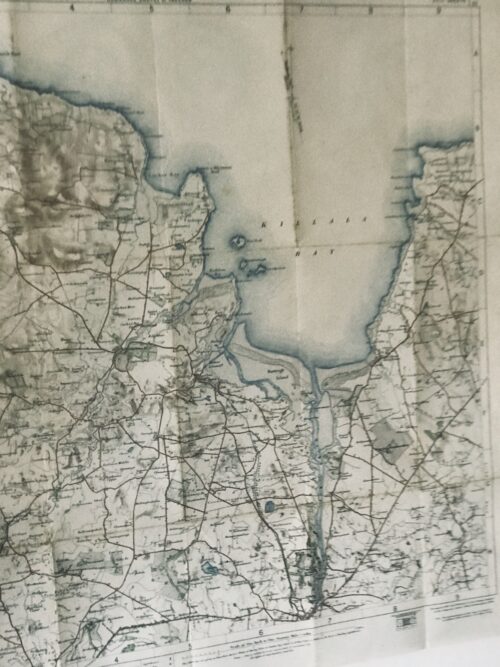
 Original ordnance survey map from 19 of Killala Bay Co Mayo in superb frame. Westport Co Mayo 65cm x 65cm Killala is a quiet seaside resort but the harbour warehouses show that it was once a busy port. This remote little town enjoys a place of disproportionate importance in the history of Ireland, as it was here that the French first halted when they invaded in 1798. The 1798 French invasion of Ireland On August 6, 1798, General Humbert’s “Army of Ireland” set sail from La Rochelle destined for Killala, Co. Mayo …
Original ordnance survey map from 19 of Killala Bay Co Mayo in superb frame. Westport Co Mayo 65cm x 65cm Killala is a quiet seaside resort but the harbour warehouses show that it was once a busy port. This remote little town enjoys a place of disproportionate importance in the history of Ireland, as it was here that the French first halted when they invaded in 1798. The 1798 French invasion of Ireland On August 6, 1798, General Humbert’s “Army of Ireland” set sail from La Rochelle destined for Killala, Co. Mayo …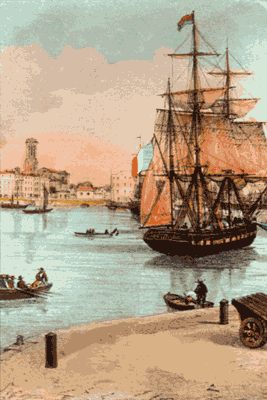
La Rochelle’s harbour.
On July 19, 1798, the French Directory authorises the sending of three expeditions to Ireland and gives command of the first one to General Humbert.
On August 6, 1798, General Humbert’s Army of Ireland sailed from La Rochelle in three frigates La Concorde, La Franchise, La Médée, carrying 1,025 French troops, 3 light field cannons, 3,000 muskets, and 400 sabres.
There were also a number of Irish among Humbert’s command. These included Bartholomew Teeling and Fr. Henry O Kane. This tiny force, together with its Irish allies, was to conduct an extraordinary campaign that shook the British Empire.During 16 days they sailed taking a circuitous route to avoid detection by the British navy. The mission of this little French expeditionary force was to provide military assistance to the Irish rebels of the “Rising of ’98” – sometimes referred to as “Bliadhan na bhFrancach” or “The Year of the French” – in their attempt to free Ireland from English domination.
The fleet had originally planned to land in Co. Donegal, but due to storm and no doubt influenced by the presence of Fr. O Kane who was a native of Killala the fleet sailed into Killala Bay.
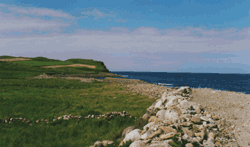
Kilcumminn head, Co. Mayo
On the 22nd of August, 1798, the three frigates landed at Kilcummin flying the English colours.
Edwin and Arthur Stock, sons of the Protestant Bishop of Killala, who had sailed out to meet them, greeted them. The two were captured, the English flag taken down and the French flag hoisted.
One of the first to disembark was Fr. O Kane who spoke to the locals in Irish which was the native tongue of most of the Irish at that time. Word soon filtered to native Irish throughout Mayo and Sligo.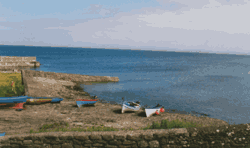
Kilcumminn strand,landing-place of the French
Bishop Stock also heard of the arrival and he sent messages to the local gentry among them the Jacksons, the Knoxs, Binghams, Palmers and Kirkwoods. Into the relative quiescence of northwest Ireland, the French expeditionary force fell like a thunderbolt. By about 7pm the landing was complete.
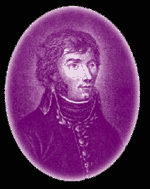
General Humbert
Young Général Jean-Joseph-Amable Humbert (the landing occurred on his 31st birthday), a canny veteran of irregular warfare against the insurgents of the Vendée, was well aware of the odds against him in a conventional military showdown, but also of the multiplying effects of surprise and speed.
He was also keenly aware of the importance of early victory for exciting the morale of the Irish insurgents and dismaying the ill-trained loyalist militia.
The first military confrontation occurred on the afternoon of 22 August, when Colonel Jean Sarrazin led a group of French Grenadiers south to the nearby village of Killala.

Killala, viewed from the north.
The garrison of 200 men included a handful of regulars of the 17th Foot (Leicestershire Regiment), but was mostly composed of the Yeomanry, an ill-trained part-time paramilitary constabulary.
With a portion of Sarrazin’s force circling around the British left flank and the remainder pressing a frontal attack with the bayonet, the unnerved Loyalists fired one ragged volley and then fled in terror towards Ballina.
Three Frenchmen were slightly wounded, bishop Stock’s palace was taken over as Humbert’s H.Q. and several of the yeomen were taken prisoner.

Ireland forever – l’Irlande pour toujours
A French soldier then climbed to the top of the palace and removed the British flag, which was replaced by a green and gold flag bearing the inscription ‘Erin Go Bragh’ (Ireland forever).
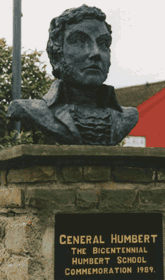
General Humbert statue in Killala.
LIBERTY, EQUALITY, FRATERNITY, UNION “After several unsuccessful attempts behold at last Frenchmen arrived amongst you . . . “Brave Irishmen, our cause is common. Like you we hold as indefeasible the right of all nations to liberty. Like you we are persuaded that the peace of the world shall ever be troubled as long as the British ministry is suffered to make with impunity a traffic of the industry and blood of the people . . . “Union, Liberty, the Irish Republic! Such is our shout. Let us march. Our hearts are devoted to you; our glory is in your happiness.”
From General Humbert’s Proclamation of 22nd August, 1798. (This last sentence of Humbert’s Proclamation became our pub’s motto!)
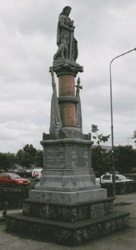
Mémorial de Ballina
This initial humbling of their oppressors had the desired effect on the local population, bringing forward thousands of eager, though ignorant and ill-disciplined Irish volunteers who were hastily equipped and formed into companies. Muskets were issued to some, but as in the uprisings elsewhere in Ireland that year, most of the insurgents were armed with crude pikes, scythes, and hay-forks.
On the 24th of August, having captured Killala, Humbert sent two groups under Sarrazin (provisionally promoted to Général de Brigade by Humbert on 23 August) and Adjudant-General Fontaine to capture Ballina.That night a fight took place between Sarrazin’s troops and the British at Rosserk. The English eventually retreated in confusion. The next morning the French/Irish troops captured Ballina under cover of darkness. The Irish peasants lit bundles of straw to show them their way. This approach road to Ballina has since been known as Bothair na Sop. They took Ballina without much resistance. The English for the most part fled towards Foxford where they would have their forces waiting for the French advance on Castlebar.
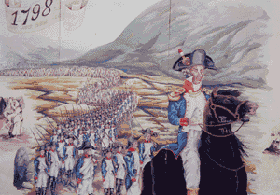
Humbert – Windy Gap Pass
The British commander in County Mayo, General Hutchinson, expected Humbert to continue south along the only decent road out of Ballina toward Castlebar, the commercial and strategic center of the region.
Where the road crosses the River Moy at Foxford, Hutchinson placed a strong blocking force with ample artillery. Clashes of French and British patrols along the Ballina-Foxford road appeared to confirm British expectations.Humbert, closely questioning the locals, learned that there was an alternative route to Castlebar, a barely-practicable goat-trail that ran west of Lough Conn, over the Windy Gap pass, and then south to the town. He resolved to take this route.
To further the deception, the Franco-Irish forces marched out of Ballina along the Foxford road at sunset on August 26 with ostentatious noise and shouted boasts of expected victory at Foxford, then doubled back in silence and darkness to the west of Loch Conn. At midnight, Humbert’s army was in Lahardane.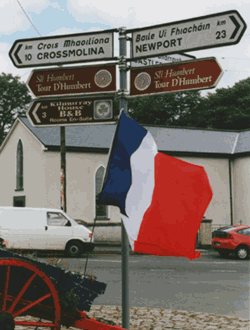
“Tour D’Humbert” signposts in Lahardane
The local priest, Father Andrew Conroy, was fluent in French from his time at seminary in Nantes.
He gave precious directions to the French officers and marshalled the people to provide food and assistance to the troops. In the aftermath of the campaign, Father Conroy was arrested, tried, and executed by the vengeful British.After a rigorous night-march of 40 km (25 miles), Humbert’s 800 French, 600 Irish, and 1 laboriously manhandled gun reached Castlebar on 27 August.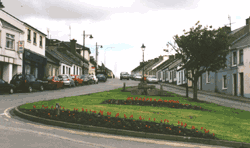
Sion Hill (now built-up)
A yeoman farmer who had been tending to his cattle had spotted the French/Irish advance party. He immediately fled to Castlebar to warn the British commander of the eminent arrival of the French/Irish forces.
The English forces took up position at Sion Hill just outside the town. Humbert approached and took account of the English position.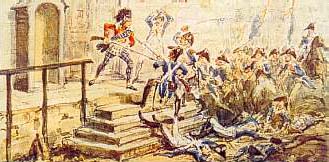
Batlle of Castlebar known as “Races of Castlebar”.
Following a number of attacks in which they were hit by British cannon, Humbert decided to regroup and divided his troops, splitting them to the left and right so as to attack the English flanks. The Irish drove a herd of cattle ahead of them causing confusion in the English rank. The French/Irish made an effective bayonet charge through the centre.
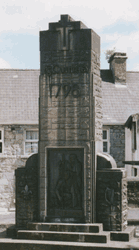
Castlebar Memorial
The English retreated down Staball Hill. Another attack occurred at Main St. Bridge. The English defended the bridge for some time using forces from the Longford and Kilkenny militias and Fraser Fencibles (a Scottish regiment).
There was confused fighting in the town as knots of the more stalwart British, notably the Fraser Fencibles and Roden’s Dragoons, attempted to make a stand.
The bulk of the redcoat forces, abandoning all guns, standards, and baggage, ran in headlong flight down the road to Tuam, 54 km (34 miles) to the southeast; some apparently did not stop until reaching Athlone, a further 68 km (42 miles) away. General Lake’s army being dissolved.
The event has since become mockingly known among the Irish as “The Castlebar Races.” In all the attack only lasted six hours from 6a.m. to 12 noon and has been described by Thomas Pakenham in The Year of Liberty as one of the most ignominious defeats in British military history. Following this brilliant victory, Humbert spent the next few days resting and reorganizing his army, absorbing many hundreds of new Irish volunteers including some 250 deserters from the Longford and Kilkenny Militias.The “Republic of Connaught” was proclaimed and a makeshift revolutionary government installed.Army of Ireland – Liberty, Equality
Head quarters at Castlebar, 14th Fructidor, sixth Year of the French Republic, One and Indivisible. General Humbert, Commander in Chief of the Army of Ireland, desirous of organizing with the least possible delay, an administrative power for the Province of Connaught, decrees as follows:
1. The Government of the Province of Connaught shall reside at Castlebar till further orders. 2. The Government shall be composed of twelve members, who shall be named by the General-in-chief of the French Army. 3. Citizen JOHN MOORE is named President of the Government of the Province of Connaught, he is specially entrusted with the nomination and reunion of the members of the Government. 4. The Government shall occupy itself immediately in organizing the Military power of the Province of Connaught, and with providing subsistence for the French and Irish Armies. 5. There shall be organized eight regiments of infantry, each of twelve hundred men, and four regiments of cavalry, each of six hundred men. 6. The Government shall declare rebels and traitors to the country all those who having received clothing and arms, shall not join the army within four and twenty hours. 7. Every individual from sixteen years of age to forty, inclusive, is REQUIRED in the name of the Irish Republic, to betake himself instantly to the French Camp, to march in a mass against the common enemy. The General Commanding-in-Chief HUMBERT.Lord Cornwallis (the same who had surrendered to Washington at Yorktown), now the Viceroy and Commander-in-Chief in Ireland, moved west from Dublin to take personal command of the campaign.It was obvious that after the fiasco of Castlebar, the Crown forces in Ireland would marshal every possible resource to crush Humbert.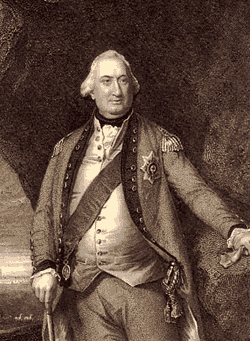
Lord Cornwallis
By the 2nd of September, Cornwallis had 7,800 men, including two reliable Scottish regiments (the Sutherland and Rehy Fencibles) concentrated at Tuam, organized into four brigades under Generals Hunter, Campbell, Hutchinson, and Moore (later the hero of Corunna), and a further 2,800 at Boyle.
Cornwallis advanced from Tuam on the 4th of September, but on arriving at Castlebar on the 5th found only a small Franco-Irish rearguard. Aware of the impossibility of defeating the well-equipped and far more numerous Crown forces, and with no sign of reinforcements from France, Humbert had marched off to the east on 4 September, under cover of darkness, taking his army, now totalling 3,000 men, towards Sligo, covering 58 miles in 36 hours. The long march had begun. Some Irish troops under French officers remained to protect Killala and receive the expected reinforcements.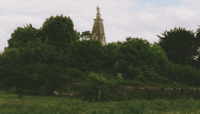
Collooney, Co. Sligo
On the morning of the 5th of September, an English army from Sligo under Col Vereker attacks the Franco-Irish army at Collooney with its left protected by the Ballysadare River and its right anchored on a steep, wooded hill. Humbert again outmanoeuvres them.
In what may be one of the greatest feats of individual bravery in the long history of the Revolutionary and Napoleonic Wars, Colonel Bartholomew Teeling, a United Irishman holding a French commission, galloped forward alone to the British line, pistolled the enemy gunner at point-blank range, and rode back unscathed under a hail of musket-fire. Inspired by his example, the Irish and French surged forward and routed the Loyalists. The English retreated with heavy losses as far as Ballyshannon, County Donegal.Cornwallis has now divided his army in two, one half under General Lake to pursue the enemy and the other half, under his own personal command, to protect the line of the river Shannon.
Ballinamuck pikeman
The French and Irish “must not cross”. Meanwhile, the United Irishmen of Longford and Westmeath have assembled. They capture Wilson’s Hospital near Mullingar but fail to take the town of Granard. Humbert, on hearing of the midlands rising decides to link up with the insurgents there.He is now near Manorhamilton but changes and goes straight for Granard. He abandons some of the heavier guns so as to make more speed. So far he has eluded the cordon closing in around him. With some luck he hopes to slip past the net, reach Granard and then strike for Dublin which is virtually unprotected as most of the garrison have been moved to Connacht. The Franco-Irish army reaches Drumkeerin in the evening of September 6. An envoy from Lord Cornwallis offers terms for surrender but they are rejected.On September 7, shortly before noon Humbert’s army crosses the Shannon at Ballintra Bridge just south of Loch Allen, but they fail in an attempt to demolish the bridge behind them.
His army shows signs of fatigue and skirmishes with the English advance guard become more frequent. The race for Granard quickens.
The Franco-Irish army reaches Cloone, in South Leitrim, while Cornwallis, with 15,000 men is at Mohill, five miles away. Humbert gets news that he is surrounded and outnumbered but decides to push on even if the best he can now do is to make a token resistance before surrender.On September 8, 1798, near the small village of Ballinamuck, County Longford, Humbert drew up his 859 French troops in line of battle. There could be little doubt of the outcome.
Behind Humbert was Cornwallis blocking Humbert’s way to Dublin. In front was Lake’s 6000 men. The battle which lasted but half an hour commenced with Colonel Crawford’s dragoons cutting through the Irish rebels. When the British grand assault poured up the hill from three sides, in overwhelming numbers, Humbert gave the order to surrender.
Humbert surrenders in Ballinamuck
The French officers followed their general’s signal and ordered their men to lay down their muskets. A second body of British cavalry had reined in seeing the signs of surrender, but Colonel Teeling, an Irish officer in the French army, had not signaled surrender so British infantry advanced on them. Crawford attacked a large contingent of Irishmen with his dragoons, their sabres sparing only those with officers insignia, hanging to be their fate.
Later testimonies reveal that on arresting Humbert, General Lake could not conceal his astonishment: “Where is your army?” Lake demanded “This is it all” Humbert replied, indicating his soldiers. “And what were you planning to do with this lot?” Lake asked. “We were going to Dublin to break the irons of a nation that suffers under your yoke” Humbert said. “That is an idea that could only be born in a Frenchman’s brains!” Lake declared.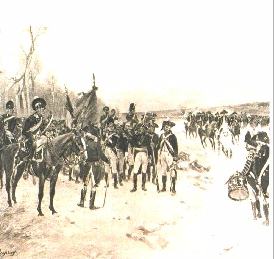
Humbert surrenders in Ballinamuck
Humbert and the French prisoners were conducted to Dublin and treated with all the consideration that could be given to gallant prisoners after an honorable defeat.
Not so the Irish. Accounts vary, but it appears that many of the Irish were cut down where they stood, or driven into the bog south of the hill where they were hunted down and slaughtered. Captured Irish officers, even those bearing legitimate commissions in the French army, were seized and hanged as traitors. Such was Bartholomew Teeling, Matthew Tone and Gunner James Magee’s fate.“After having obtained the greatest successes and made the arms of the French Republic triumph during my stay in Ireland, I have at length been obliged to submit to a superior force of 30,000 troops.” General Humbert’s Report to the French Directory after Ballinamuck.
‘A SHORT BUT VERY FATIGUING CAMPAIGN’
English historians have always treated General Humbert’s expedition to Ireland with ridicule, but Brian O hUiginn was fond of quoting Plowden the military correspondent of the London Times who held a different view. This expert wrote some years ago:
“In these operations described by Cornwallis to the Duke of Portland as a short but very fatiguing campaign, a raiding party of 1000 French landed in Ireland without opposition, after sixteen days of navigation, unobserved by the British Navy; defeated and drove back the British troops opposing them on four separate occasions; routed a force of second line troops of at least double its strength; captured eleven British guns; held the field for seventeen days; entirely occupied the attention of all the available troops of a garrison of Ireland 150,000 strong; penetrated almost to the centre of the island, and compelled the Lord Lieutenant to send an urgent requisition to London for ‘as great a reinforcement as possible.’ “
This was a fine tribute to General Humbert and his troops.- In Humbert’s footsteps 2013 – Killala & Castlebar
- In Humbert’s footsteps 2013 – Killala & Castlebar
- In Humbert’s footsteps 2013 – Killala & Castlebar
- In Humbert’s footsteps 2013 – Killala & Castlebar
The Charentais of the expedition.
Many Charentais took part in the expedition. Among them: Daniel Savary, who was born in Salles sur Mer (17), was in command of the naval division charged with transporting the expedition from La Rochelle to Killala. François Babin, born in Péré (17), became Commander of the Castlebar battalion. Jean Jobit, born in Chateauneuf en Charente (16), was a Commander on the Castlebar battlefield in Castlebar. Jean-Paul Leugerat, born in Barbezières (16), died during the battle of Castlebar. -
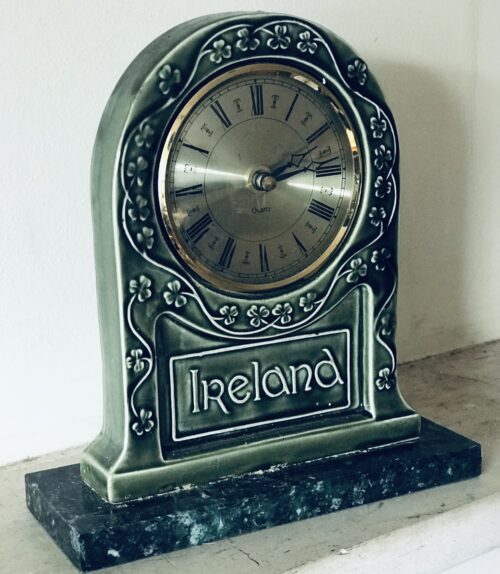
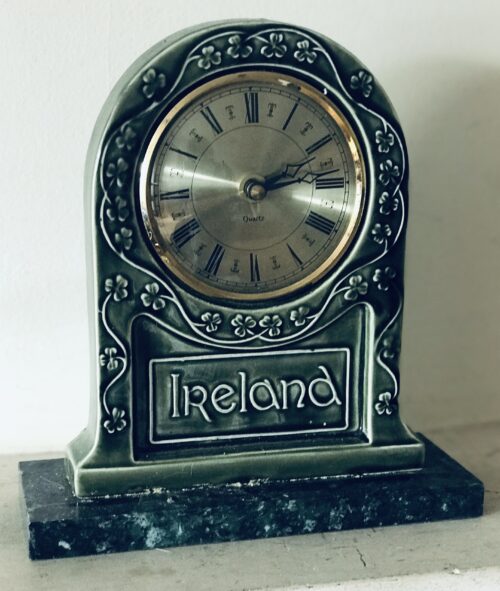 Quaint green ceramic clock with Irish theme,manufactured by Knock Pottery,Co Mayo. 23cm x 22cm x8cm Knock (Irish Cnoc Mhuire, 'Hill of the Virgin Mary') is a major international Catholic pilgrimage and prayer site. On August 21st, 1879, the Virgin Mary, St Joseph and St John the Evangelist, appeared on the south gable of Knock Parish Church. This Apparition was witnessed by fifteen local people, young and old. As a result, Knock became a major Irish pilgrimage site of prayer and worship. In the latter part of the 20th century Knock's popularity increased steadily, making it one of Europe's major Catholic Marian shrines, together with Lourdes and Fatima. Today this shrine is visited by one and a half million pilgrims annually. In 1979, Knock was visited by Pope John Paul II, to commemorate the centenary of the apparition. Mother Teresa of Calcutta visited the Shrine in June 1993 Monsignor James Horan was parish priest of Knock from 1967, until his death in 1986. In that period of his service to the parish of Knock, he accomplished some landmark achievements, amongst them the building of a new basilica in 1976, which can accommodate 10,000 people, and also the construction of Ireland West Airport Knock, which he saw completed in 1985. Monsignor Horan was also instrumental in organising the visit of Pope John Paul II to the shrine in 1979Knock Shrine is open all year round. The main pilgrimage season extends from the last Sunday in April until the second Sunday in October. The clock mechanism in good working order. Origins : Co Mayo Dimensions : 22cm x 21cm 4kg
Quaint green ceramic clock with Irish theme,manufactured by Knock Pottery,Co Mayo. 23cm x 22cm x8cm Knock (Irish Cnoc Mhuire, 'Hill of the Virgin Mary') is a major international Catholic pilgrimage and prayer site. On August 21st, 1879, the Virgin Mary, St Joseph and St John the Evangelist, appeared on the south gable of Knock Parish Church. This Apparition was witnessed by fifteen local people, young and old. As a result, Knock became a major Irish pilgrimage site of prayer and worship. In the latter part of the 20th century Knock's popularity increased steadily, making it one of Europe's major Catholic Marian shrines, together with Lourdes and Fatima. Today this shrine is visited by one and a half million pilgrims annually. In 1979, Knock was visited by Pope John Paul II, to commemorate the centenary of the apparition. Mother Teresa of Calcutta visited the Shrine in June 1993 Monsignor James Horan was parish priest of Knock from 1967, until his death in 1986. In that period of his service to the parish of Knock, he accomplished some landmark achievements, amongst them the building of a new basilica in 1976, which can accommodate 10,000 people, and also the construction of Ireland West Airport Knock, which he saw completed in 1985. Monsignor Horan was also instrumental in organising the visit of Pope John Paul II to the shrine in 1979Knock Shrine is open all year round. The main pilgrimage season extends from the last Sunday in April until the second Sunday in October. The clock mechanism in good working order. Origins : Co Mayo Dimensions : 22cm x 21cm 4kg -

 26cm x 33cm Fantastic shot of the most westerly GAA pitch in Ireland and prob in Western Europe-the pitch on Care Island where the resourceful locals have mangaged to produce a decent playing surface on the only flat patch of land on the island ! Inishturk (Inis Toirc in Irish, meaning Wild Boar Island) is an inhabited island of County Mayo, in Ireland.
26cm x 33cm Fantastic shot of the most westerly GAA pitch in Ireland and prob in Western Europe-the pitch on Care Island where the resourceful locals have mangaged to produce a decent playing surface on the only flat patch of land on the island ! Inishturk (Inis Toirc in Irish, meaning Wild Boar Island) is an inhabited island of County Mayo, in Ireland.Geography
The island lies about 15 km (9 mi) off the coast; its highest point reaches 189.3 m (621.1 ft) above sea level. Between Inisturk and Clare Island lies Caher Island. It has a permanent population of 58 people.There are two main settlements, both on the more sheltered eastern end of the island, Ballyheer and Garranty. Bellavaun and Craggy are abandoned settlements. The British built a Martello tower on the western coast during the Napoleonic Wars. Inisturk has the highest per capita donation rate towards the RNLI in the whole of Ireland.History
Inishturk has been inhabited on and off since 4,000 BCE and has been inhabited permanently since at least 1700. Some of the more recent inhabitants are descended from evacuees from Inishark to the southwest. The social club Mountain Common is situated on the hill that separates the two settlements.Recent history
In 1993 Inishturk Community centre was opened, this community centre doubles as a library and a pub. In June 2014 the ESB commissioned three new Broadcrown BCP 110-50 100kVA diesel generators to supply electricity to the island The ESB have operated a diesel power station on the island since the 1980s Inishturk gained international attention in 2016 after a number of websites claimed that the island would welcome any American "refugees" fleeing a potential Donald Trump presidency.These claims were used as one example of the type of "fake news" that arose during the 2016 US presidential election campaign. As of November 2016, no changes to inward migration have been reported. The island is home to a primary school on the island which in 2011 had only 3 pupils, this believed to be the smallest primary school in IrelandDemographics
The table below reports data on Inisturk's population taken from Discover the Islands of Ireland (Alex Ritsema, Collins Press, 1999) and the Censusof Ireland.Historical population Year Pop. ±% 1841 577 — 1851 174 −69.8% 1861 110 −36.8% 1871 112 +1.8% 1881 116 +3.6% 1891 135 +16.4% 1901 135 +0.0% 1911 132 −2.2% 1926 101 −23.5% Year Pop. ±% 1936 107 +5.9% 1946 125 +16.8% 1951 123 −1.6% 1956 110 −10.6% 1961 108 −1.8% 1966 92 −14.8% 1971 83 −9.8% 1979 85 +2.4% 1981 76 −10.6% Year Pop. ±% 1986 90 +18.4% 1991 78 −13.3% 1996 83 +6.4% 2002 72 −13.3% 2006 58 −19.4% 2011 53 −8.6% 2016 51 −3.8% Source: Central Statistics Office. "CNA17: Population by Off Shore Island, Sex and Year". CSO.ie. Retrieved October 12, 2016. Transport[edit]
Prior to 1997 there was no scheduled ferry service and people traveled to and from the islands using local fishing boats. Since then a ferry service operates from Roonagh Quay, Louisburgh, County Mayo.[13] The pier was constructed during the 1980s by the Irish government, around this time the roads on the island were paved.[14] -
Out of stock
 John Skelton was born in Armagh in 1925. A very talented artist who delighted in portraying the ordinary men and women of Rural Ireland, his works are on permanent display in the Joyce Collection of Northwestern University of Illinois,the headquarters of the ESB,Bank of Ireland and the Embassy of South Korea. Skelton started his professional career in London, where he came under influence of Euston Road School in the late 1940s. In 1946 he married Caroline, settling four years later in Dublin. He worked initially in advertising as Art Director and illustrator of books, most of them educational. After 1975 he worked full-time as a painter. He had numerous one man shows in Dublin; two in Belfast, one in Los Angeles and one in the Mystic Seaport Museum in Connecticut. Up to the late 1980s, Skelton was a frequent exhibitor in group shows, particularly the annual Royal Hibernian Academy and the Watercolour Society shows in Dublin. In recent years, however, his work was in such demand that he contributed to these less often. During the 1970s and earlier 1980s he earned a reputation as a gifted teacher and lecturer in the National College of Art and Design in Dublin. John Skelton's grave can be found at Mount Jerome Cemetery, Harold's Cross, Dublin, Ireland. Origins:Co Mayo Dimensions :29cm x 36cm
John Skelton was born in Armagh in 1925. A very talented artist who delighted in portraying the ordinary men and women of Rural Ireland, his works are on permanent display in the Joyce Collection of Northwestern University of Illinois,the headquarters of the ESB,Bank of Ireland and the Embassy of South Korea. Skelton started his professional career in London, where he came under influence of Euston Road School in the late 1940s. In 1946 he married Caroline, settling four years later in Dublin. He worked initially in advertising as Art Director and illustrator of books, most of them educational. After 1975 he worked full-time as a painter. He had numerous one man shows in Dublin; two in Belfast, one in Los Angeles and one in the Mystic Seaport Museum in Connecticut. Up to the late 1980s, Skelton was a frequent exhibitor in group shows, particularly the annual Royal Hibernian Academy and the Watercolour Society shows in Dublin. In recent years, however, his work was in such demand that he contributed to these less often. During the 1970s and earlier 1980s he earned a reputation as a gifted teacher and lecturer in the National College of Art and Design in Dublin. John Skelton's grave can be found at Mount Jerome Cemetery, Harold's Cross, Dublin, Ireland. Origins:Co Mayo Dimensions :29cm x 36cm -

 Superb Guinness advert publicising their sponsorship of the All Ireland Senior Hurling Championship-unframed print. 44cm x 60cm Guinness were long time sponsors of the All Ireland Senior Hurling Championship.Hurling is an ancient sport ,played for over 2000 years by such mythical Irish legends such as Setanta, who is depicted here in this distinctive Guinness advert fighting off a fierce wolf, armed with just a Hurl and a sliotar! Following on the company’s imaginative marketing and advertising campaigns — with such slogans as ‘Not Men But Giants,’ ‘Nobody Said It Was Going To Be Easy’ and ‘The Stuff of Legend’ — other imaginative adverts brought the message that hurling is part of the Irish DNA. Other campaigns, entitled ‘It’s Alive Inside’ focused on how hurling is an integral part of Irish life and how the love of hurling is alive inside every hurling player and fan.
Superb Guinness advert publicising their sponsorship of the All Ireland Senior Hurling Championship-unframed print. 44cm x 60cm Guinness were long time sponsors of the All Ireland Senior Hurling Championship.Hurling is an ancient sport ,played for over 2000 years by such mythical Irish legends such as Setanta, who is depicted here in this distinctive Guinness advert fighting off a fierce wolf, armed with just a Hurl and a sliotar! Following on the company’s imaginative marketing and advertising campaigns — with such slogans as ‘Not Men But Giants,’ ‘Nobody Said It Was Going To Be Easy’ and ‘The Stuff of Legend’ — other imaginative adverts brought the message that hurling is part of the Irish DNA. Other campaigns, entitled ‘It’s Alive Inside’ focused on how hurling is an integral part of Irish life and how the love of hurling is alive inside every hurling player and fan. -

 Superb Guinness advert publicising their sponsorship of the All Ireland Senior Hurling Championship. 62cm x 84cm Guinness were long time sponsors of the All Ireland Senior Hurling Championship.Hurling is an ancient sport ,played for over 2000 years by such mythical Irish legends such as Setanta, who is depicted here in this distinctive Guinness advert fighting off a fierce wolf, armed with just a Hurl and a sliotar! Following on the company’s imaginative marketing and advertising campaigns — with such slogans as ‘Not Men But Giants,’ ‘Nobody Said It Was Going To Be Easy’ and ‘The Stuff of Legend’ — other imaginative adverts brought the message that hurling is part of the Irish DNA. Other campaigns, entitled ‘It’s Alive Inside’ focused on how hurling is an integral part of Irish life and how the love of hurling is alive inside every hurling player and fan.
Superb Guinness advert publicising their sponsorship of the All Ireland Senior Hurling Championship. 62cm x 84cm Guinness were long time sponsors of the All Ireland Senior Hurling Championship.Hurling is an ancient sport ,played for over 2000 years by such mythical Irish legends such as Setanta, who is depicted here in this distinctive Guinness advert fighting off a fierce wolf, armed with just a Hurl and a sliotar! Following on the company’s imaginative marketing and advertising campaigns — with such slogans as ‘Not Men But Giants,’ ‘Nobody Said It Was Going To Be Easy’ and ‘The Stuff of Legend’ — other imaginative adverts brought the message that hurling is part of the Irish DNA. Other campaigns, entitled ‘It’s Alive Inside’ focused on how hurling is an integral part of Irish life and how the love of hurling is alive inside every hurling player and fan.








